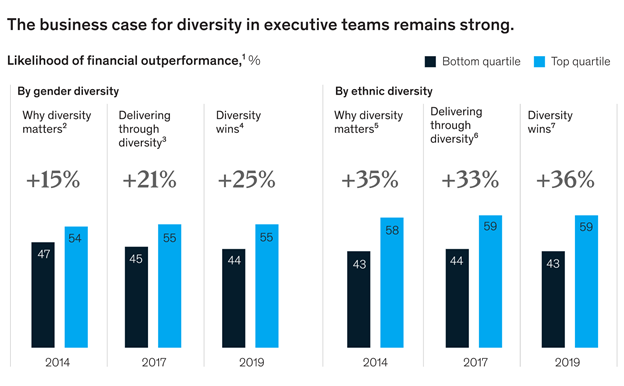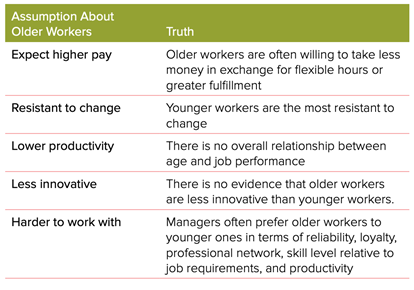People say that using a diversity recruitment strategy is the right thing to do. It’s also the smart thing to do. In this article, we explain why and how to improve your own strategy.
A reputation of a company that appreciates differences is a great way to attract more talented employees. Not to mention increased creativity, productivity, employee engagement, and other benefits of cultural diversity in the workplace.
This post is here for companies that need to improve their diversity recruiting strategy and take advantage of these benefits.
We’ll go through seven practical tips and best practices for businesses, regardless of the industry. Also, we’ll talk about how to retain diverse employees during the pandemic.
By the time you’re done reading, you’ll know what it takes to recruit top diverse talent and retain them effectively.
What is diversity recruiting strategy?
Diversity recruiting strategy is a practice of seeking and recruiting candidates from diverse backgrounds and implementing methods for minimizing bias in the process.
Companies implementing diversity recruiting strategy have a diverse set of employees with different ethnic backgrounds, ages, cultures, life experiences, educational qualifications, and physical abilities.
Why is diversity important for your organisation?
A diverse team brings together unique personalities, skills, perspectives, which leads to smarter decisions and new ideas.

One of the most comprehensive studies on the benefits of workplace diversity was done by McKinsey. In 2019, they’ve surveyed 1,000 companies from 15 countries and found the following.
According to Diversity Wins: Why Inclusion Matters – that’s the title of the study’s report, companies with higher gender and ethnic diversity performed better in a number of critical performance areas.
Here’s the whole data by years. The image shows that companies in “the top quartile” for gender diversity, for example, were 25 percent more likely to reach above-average profitability compared to those in “the bottom quartile.”

Source: Diversity Wins: Why Inclusion Matters, McKinsey
The higher profitability is the result of benefiting from the advantages provided by diversity in the workplace. Behind that, of course, there’s a strong organisational commitment to making diversity recruiting strategy work.
This means constantly improving diversity recruitment practices and making the workplace and promoting diversity in the workplace with workforce policies.
Now, let’s see how you can do that, too.
How to improve your diversity recruiting strategy: 7 practical tips
Go through these to find new ideas on how to update the diversity recruiting strategy in your company.
1. Evaluate What Doesn’t Work Right Now
To start improving, you need to assess your performance.
Ask yourself, “What are the weaknesses of our current diversity recruiting strategy? Are there some things you could be doing better?”
The common mistakes in implementing diversity recruitment are:
- A lack of diversity-friendly workplace policies. You might be doing a great job hiring diverse candidates, but they might quit early because of company cultural problems
- Failing to use diversity hiring job boards. You may have chosen the most popular job boards where minority candidates might be underrepresented
- Letting bias affect your decisions. Let’s be honest, we can’t escape all of our biases, so you might just need more effective strategies to minimize them
- Focusing too much on primary diversity characteristics (age, gender, race, ethnicity, and physical ability). Diversity recruiting is much more than that and includes secondary characteristics related to worldview, life experience, religion, educational background, belief system, marital status, and more.
Identify the weaknesses and missed opportunities for your current strategy by assessing your performance.
In the next sections, you’ll find tips on how to start improving today.
2. Update Your Workplace Diversity Policies
How do you promote diversity in the workplace consistently?
Right, with diversity-friendly workplace policies, supported by all leadership levels.
As mentioned, a lack of these effective policies might be a reason why diverse employees leave after being with you for a few months. On the other hand, having the policies greatly enhances your employer brand and employee reviews.
So, you need to assess and improve your workplace policies.
Follow these tips:
Introduce a policy for honoring a variety of religious and cultural practices. This means allowing days off for religious holidays, providing prayer and meditation rooms, and even foot-washing stations that Muslim employees need for ritual cleansing (see image below)

An office-based foot-washing station. Source: Society of Human Resource Management (SHRM)
Make a pay equality policy. Your company should have zero-tolerance toward gender pay inequality, which should be made into a transparent policy
Provide language courses. Multilingual workforces in international companies could benefit from learning other languages to be able to communicate with everyone
Make the workplace more friendly to older workers. Tap into the skill sets of older workers by offering flexible work arrangements, creating new positions, and adapting workplace ergonomics. Many companies are discouraged from building a multigenerational workforce due to assumptions, which are mostly inaccurate (see the image below).

Source: Harnessing the Power of a Multigenerational Workforce, SHRM
While you should definitely read some online research papers on multicultural management, the best way to start building appropriate organisation policies is to ask your employees.
Run a quick survey asking them about their preferences and recommendations and update your workplace policies as requested.
Related: Guide to Effective Diversity Management in a Multicultural Workplace
3. Reduce Bias in Recruitment and Interviewing
We can’t fully eliminate bias in HR even if we try our very best. Still, we can minimize it by constantly updating recruitment and interview processes where bias is involved.
Consider these tips to guide your effort.
- Involve diverse employees in the hiring process. Diversity attracts diversity, so try including a small team of diverse employees in candidate review process
- Have goals before hiring. Your company should have specific KPIs (more about them later in this post), e.g., “hire three employees who studied in non-Ivy League schools,” “hire a person older than 50,” etc.
- Partner with minority serving educational institutions. Create a hiring program with a minority serving college and invite some interns to come work for you
- Delete personal data from resumes. Remove the candidate’s name, age, marital status, and other information that might affect your hiring decision to be more objective.
Together, these tips will help to minimize bias in your recruitment processes
4. Update the Language in Your Job Postings
Check the copy you’re using in job descriptions. By using age or gender clues in them, you could easily discourage many talented candidates from applying.
On the other hand, gender-neutral worded descriptions get 42 percent more applicants. So, try a more neutral language in the descriptions. Use “they” instead of “he” or “she” or switching terms like “salesman” to “salesperson.”
If you need to check a job ad for gendered language, there are tools for that. Gender Decoder for Job Ads is one. Paste your text in the editor and run the check. The tool generates a report with recommendations in seconds, for free.
Here’s a sample report generated for a random job ad from LinkedIn.

Source: Gender Decoder
Check every job description you create, and you’ll increase the chances of attracting more applicants.
5. Use Job Boards for Diverse Hiring
Did you know that there are diverse hiring job boards?
Your HR folks can attract more diverse candidates by searching for them there or posting jobs at these platforms.
Here are the best options to check out:
- Black Career Network. A platform for finding high-engaged diverse candidates from all over the U.S.
- workplacediversity.com. A veteran and minority-owned job site with a vast pool of Latino, African American, LGBT, veteran, female, and Asian American professionals
- FairyGodBoss. Female candidates of all skill levels, from all over the world
- Female Executive Search. Find an experienced female executive from different parts of the world to make your top management team more diverse
Your talent acquisition folks should have at least several go-to diversity hiring websites like these, so keep looking regularly.
6. Establish Your Employer Brand
“Employer brand” sounds like a buzzword, but it’s actually a legit way to get top talent.
Think about it: B2C companies do a lot to create a brand that appeals to a specific target audience. You can take the same approach with the employer brand to attract specific candidates.
The most important elements of cultivating an image of an employer that appreciates diversity are:
- Writing neutral-worded job descriptions
- Having diversity-friendly workplace policies
- Having diverse management teams
- Ensuring pay equality across the entire organisation
- Targeting diverse candidates in job applications and other materials used in the recruiting strategy.
Organizations that truly value diversity and inclusion and build their employer brand make some steps to be better in every area.
Read this case study by Miles Burke, the founder of 6Q, on how he encourages diversity in content marketing.
7. Measure Your Performance with KPIs and Employee Surveys
We propose to use the combination of KPIs and employee surveys for one good and simple reason.
Not everything can be measured in numbers.
Many companies make a mistake by focusing too much on numbers. For example, if one expresses the number of women in a department with a percentage, in reality, one measures representation, and not how diverse-friendly their company is.
Adding regular employee surveys to the mix completes the picture by introducing qualitative feedback. With them, you can learn about:
- diverse employees’ happiness and job satisfaction
- feedback about workplace diversity policies
- diverse employees’ assessment of the performance of your company’s diversity & inclusion efforts
- motivation and mood trends.
With 6Q Employee Surveys, for example, you can use 200 pre-written questions, write your own, and receive weekly reports on employee well-being, job satisfaction, company culture, and even team mood trends (see the graph below).

Team Mood Trend in 6Q
And the best news is that the employees can answer your questions anonymously.
As for the KPIs, you need to set relevant indicators to avoid wasting your time measuring the wrong things.
Here are the areas that you might use KPIs for:
- Representation. It’s the percentage of diverse employees compared to the entire company/department
- Retention. The average tenure of diverse employees compared to the average tenure of members of the majority group
- The number of recently hired diverse employees against the majority of employees
- The comparison of both financial and non-financial rewards between the members of the dominant group and minority employees
- Promotion. The comparison of the promotions awarded to minority employees and other groups.
With that said, you can’t improve what you can’t measure.
So, try using both KPIs and surveys to ensure that your diversity recruiting strategy and workplace diversity policies are moving your business in the right direction.
Related: How to Measure Team Mood with 6Q
The Effect of the COVID-19 Pandemic on Your Diversity Recruiting Strategy
At this time, the world is going through a serious outbreak of the novel coronavirus. You might be forced to stop hiring at the moment, which might be necessary. Now, your focus should be on retaining your diverse workers and helping them get through the crisis.
Why retention?
The impact of the lockdown on women and minorities is much more serious.
For example, women from low-income families need to stay at home to be with their kids, which makes them highly vulnerable to job cuts. With their job security threatened, they might experience higher levels of stress, which affects their performance.
The latest U.S. unemployment figures also paint a grim picture. Today, the unemployment rate among African Americans continues to increase despite a two-percentage-point decrease for White workers.
With the rate for Black workers being higher historically (as shown in the image below), the situation around the pandemic can make the situation much worse.

Source: CNBC
Your job as an employer is to minimize the effect of the crisis on all your employees. Making the workplace diversity a priority means working on it especially hard during times like these.
The first step you can take is to understand how your diverse employees are affected by the pandemic. Good communication with them is the key to that.
Good ideas to try:
- Have one-on-one meetings. Schedule a video meeting with each employee. Ask them how they have been handling the crisis and what their biggest worries are
- Run regular workforce surveys. It might not be possible to collect feedback with the one-on-ones every week, but online employee surveys make it possible. You can ask them how they feel, how you can help, and other things to make them feel valued and heard.
The best way to support your diverse employees during the crisis is to maintain regular communication with them (and not just about the work-related things).
In Summary
Making a diverse recruiting strategy work is a challenge.
It can be a bit complicated and requires your long-term commitment, but if you do commit, your efforts will be nicely rewarded. You’ll make your company a welcoming, positive place to work for everybody as well as a powerhouse of fresh ideas and business strategies. This is something that will serve you in the years to come.
About the Author
Dorian Martin is a progressive business writer and editor. He specialises in HR and often serves as a freelance advisor on content strategies for small businesses. When Martin is not creating content, he reviews the best writing services or goes to webinars on digital marketing and talent acquisition.



